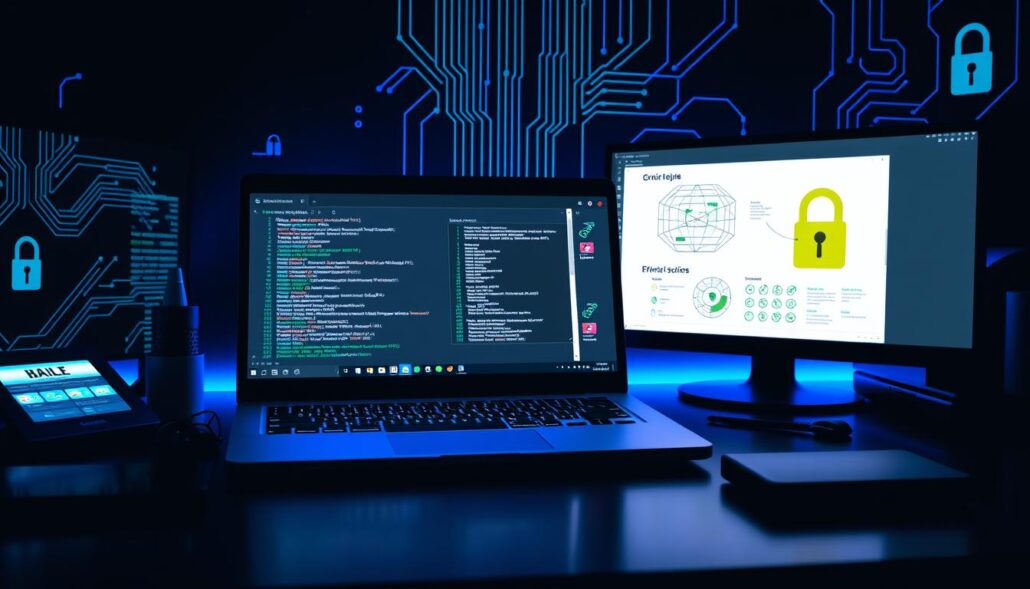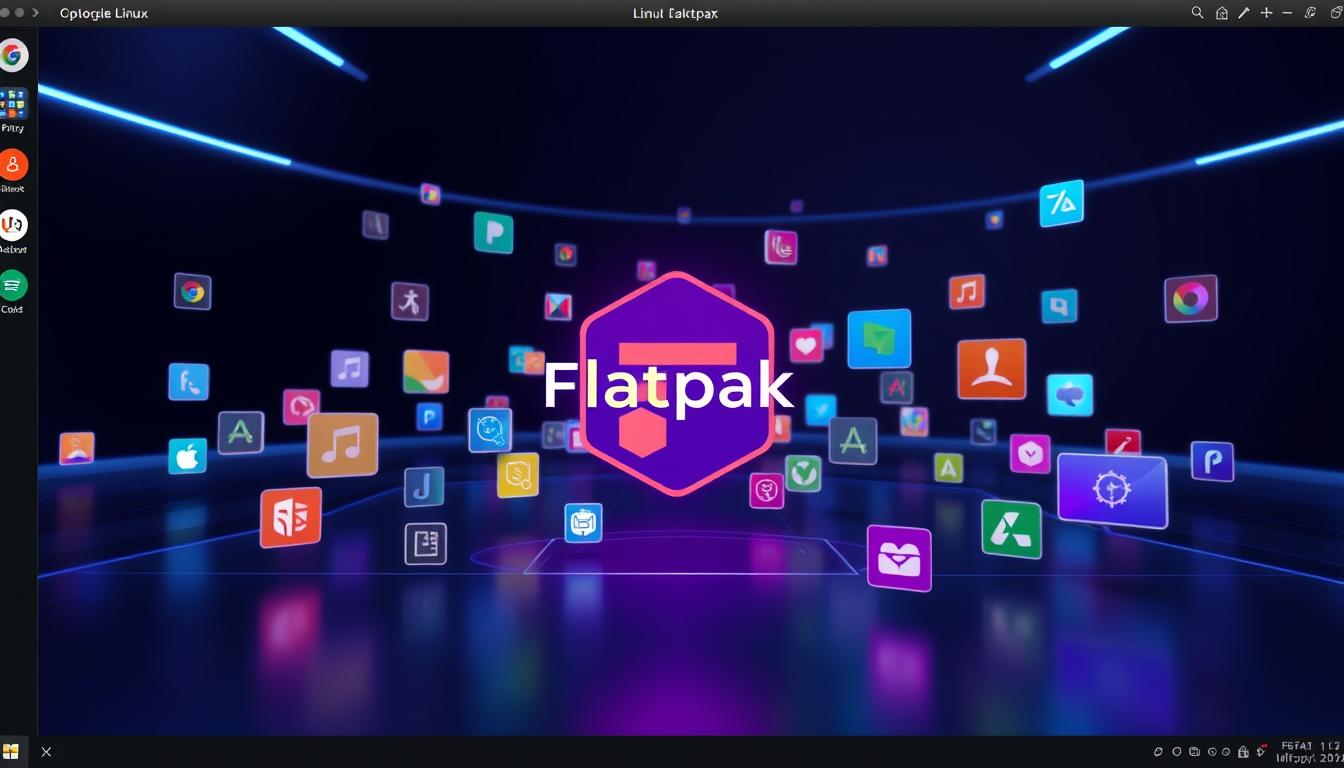I’m excited to share my knowledge on using Kali Linux for penetration testing and ethical hacking. This guide will teach you the key techniques and tools for better cybersecurity skills. It’s perfect for both experienced hackers and newcomers, offering a deep dive into Kali Linux.
Key Takeaways
- Discover the power of Kali Linux, the premier platform for ethical hacking and penetration testing
- Learn how to set up a robust Kali Linux environment and utilize its extensive suite of security tools
- Understand the principles of reconnaissance, vulnerability assessment, and exploitation in the context of Kali Linux
- Explore techniques for web application and wireless network pentesting to enhance your cybersecurity skills
- Gain insights into the ethical hacking best practices to ensure your penetration testing efforts are conducted responsibly and effectively
Introduction to Kali Linux
Kali Linux is a strong, open-source operating system. It’s a top pick for security experts, penetration testers, and ethical hackers. Developed by Offensive Security, it’s made for deep security analysis and penetration testing.
What is Kali Linux?
Kali Linux is based on Debian and comes with over 600 security and forensic tools. It’s seen as a top choice for Kali Linux for penetration testing and Kali Linux ethical hacking. It has tools for network scanning, vulnerability assessment, web application testing, and wireless hacking.
Why Kali Linux is Essential for Pentesting
Kali Linux is key for security pros because of its wide range of tools. Here’s why it’s important for Kali Linux introduction:
- It has over 600 pre-installed tools for various security tasks.
- It’s customizable and flexible, allowing for a tailored toolkit.
- It can be booted from a USB drive or a Live CD/DVD, making it portable.
- It’s updated regularly with the latest tools and bug fixes.
In short, Kali Linux is a powerful tool for security experts, penetration testers, and ethical hackers. It has a vast array of tools, is customizable, and keeps getting better. This makes it the first choice for Kali Linux for penetration testing and Kali Linux ethical hacking.
Setting Up the Kali Linux Environment
To use Kali Linux for penetration testing, setting up the environment is key. I’ll show you how to install Kali Linux, configure it, and make it ready for testing.
Installing Kali Linux
First, download and install Kali Linux. It’s free on the official website. Follow the instructions to make a bootable USB or CD/DVD and install it.
Configuring Kali Linux
After installing, configure Kali Linux for testing. Here are important steps:
- Update the system: Make sure you have the latest Kali Linux and all updates.
- Enable networking: Set up your network so Kali Linux can connect to the internet and target systems.
- Install additional tools: Kali Linux has many tools, but you might need more. Install them as needed.
- Customize the user interface: Change the desktop, themes, and shortcuts to fit your style and workflow.
Optimizing Kali Linux for Pentesting
To maximize Kali Linux for testing, optimize it further. Here’s how:
- Configure virtual machines: Create virtual machines to keep your testing separate and safe.
- Secure the system: Protect your Kali Linux and data with security measures.
- Familiarize yourself with the tool: Learn the many tools in Kali Linux and how to use them.
By following these steps, you’ll have a Kali Linux environment ready for testing. Next, we’ll explore the essential tools in Kali Linux.
Essential Pentest Tools in Kali Linux
Kali Linux is a top choice for ethical hackers. It has many tools, but Nmap and Wireshark are key. Nmap maps networks, and Wireshark analyzes network protocols.
Nmap: The Network Mapper
Nmap is a powerful tool for network exploration. It scans ports, finds active devices, and identifies operating systems. This info is vital for the first steps of a Kali Linux pentest.
Wireshark: Network Protocol Analyzer
Wireshark digs into network traffic details. It captures and analyzes packets, showing communication patterns and vulnerabilities. It’s great for Nmap scans, helping to understand the results.
Nmap and Wireshark are essential for Kali Linux pentest tools. They help hackers understand their targets deeply.
Reconnaissance Techniques
Reconnaissance is key to a successful penetration test. As an ethical hacker, improving your reconnaissance skills is vital. This helps you gather important info about the target system or network. Here, we’ll look at active and passive reconnaissance techniques and how to use them in your Kali Linux pentest workflow.
Active Reconnaissance
Active reconnaissance means directly interacting with the target to get info. This includes port scanning, vulnerability scanning, and trying to get unauthorized access. It gives detailed info but risks being caught and facing legal issues.
Passive Reconnaissance
Passive reconnaissance gathers info without touching the target. It involves searching public databases, looking at social media, and analyzing public info. It’s less risky but might not give as much detail as active methods.
When using Kali Linux for reconnaissance, balance active and passive techniques. This way, you get a full picture of the target. Mastering both methods helps you find and fix vulnerabilities, making your penetration tests more effective.

| Technique | Description | Risk Level |
|---|---|---|
| Active Reconnaissance | Direct interaction with the target system or network | Higher |
| Passive Reconnaissance | Gathering information without direct interaction | Lower |
Vulnerability Assessment and Exploitation
After gathering information through reconnaissance, the next step is to find and use vulnerabilities in the target system or network. As an ethical hacker with Kali Linux, I’ll show you how to do a thorough Kali Linux vulnerability assessment and Kali Linux vulnerability exploitation. This helps us find and fix potential weaknesses.
Identifying Vulnerabilities
The first step is to use Kali Linux tools to scan the target and find vulnerabilities. Some top tools for penetration testing vulnerability management in Kali are:
- Nessus: A top vulnerability scanner that finds and reports many security flaws.
- OpenVAS: A detailed, full-featured scanner that analyzes potential weaknesses deeply.
- Metasploit: A versatile framework that makes exploiting vulnerabilities easier.
By running these tools and analyzing the data, we understand the target’s attack surface. We then focus on the most critical issues to fix.
Exploiting Vulnerabilities
Once we find vulnerabilities, we try to exploit them. Kali Linux offers many tools and methods for this, such as:
- Metasploit: It has a huge library of exploit modules for known vulnerabilities.
- Armitage: A user-friendly GUI for Metasploit that makes exploiting vulnerabilities easier.
- Custom scripts: Experienced ethical hackers can write their own scripts for specific vulnerabilities or to automate complex tasks.
Using these tools and methods, we show the real-world effects of vulnerabilities. This helps organizations focus on fixing them quickly.
“Vulnerability assessment and exploitation is a critical step in the penetration testing process, as it allows us to uncover and address potential weaknesses in a targeted system or network.”
Web Application Pentesting
Kali Linux is great for web application pentesting. Web apps are often attacked, and Kali Linux has tools to check and protect them.
Kali Linux web application pentesting is about finding and using web app weaknesses. It uses web application security testing to find vulnerabilities.
Kali Linux has many tools for web app testing. Tools like Burp Suite, OWASP ZAP, and sqlmap help find and use web app weaknesses.
Learning Kali Linux web hacking helps security experts understand web app security. This lets them fix weaknesses and protect online resources better.
“Web application security is a critical component of any comprehensive cybersecurity strategy. Kali Linux provides the tools and techniques needed to thoroughly assess and safeguard these vital digital assets.”
Kali Linux is a big help for web app security, whether you’re experienced or new. It’s a key tool for keeping web apps safe from threats.

Wireless Network Pentesting
Wireless networks are a big challenge in cybersecurity. Kali Linux gives us the tools to tackle these challenges. We’ll focus on cracking WEP and WPA/WPA2 encryption to protect these networks.
Cracking WEP and WPA/WPA2 Encryption
Wireless encryption has grown, but it’s not foolproof. Kali Linux offers tools to test wireless network security. We can find weaknesses and crack WEP and WPA/WPA2 encryption to protect networks.
Learning about wireless network hacking helps us keep our networks safe. Let’s dive into wireless pentesting and discover the secrets of these invisible networks.
“Wireless security is not just a convenience, but a necessity in today’s digital landscape.”
Whether you’re a pro or just curious, this journey will teach you a lot. We’ll explore Kali Linux wireless pentesting together. Let’s learn how to secure our wireless networks.
pentest with kali: Ethical Hacking Best Practices
As a professional ethical hacker, I know how vital it is to follow ethical guidelines. I make sure my Kali Linux-based tests are done legally and responsibly. This keeps my work both ethical and professional.
First, getting the right permission is key. I need written consent from the people or companies I test. Without it, I could face legal trouble and lose trust.
Also, I always respect the privacy and security of the systems I test. I avoid causing harm and report any big findings right away. Following these rules helps make the systems I test safer for everyone.








Leave a Reply